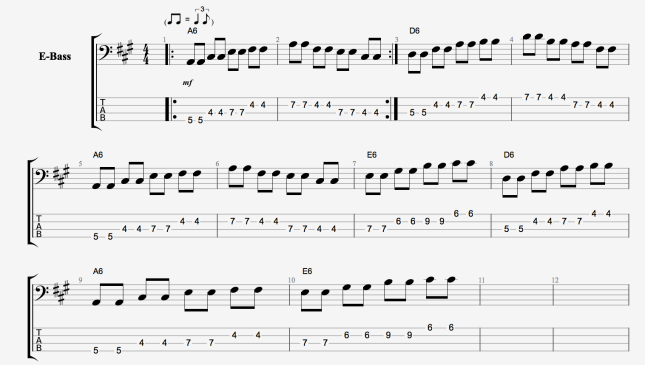Hi there,
Thanks for reading my blogs – I’ll shortly be moving over to Blogger as I can upload Videos for free. I’ll let everyone know once I start moving things over!
So in this blog we will cover some cool essential bass lines that all bassists should know. They are also extremely useful for blues guitarists as well as can be played around with on guitar in different ways.
Our first cool bass line is based around a major 6th arpeggio. An arpeggio is where you are playing notes from a chord sequentially.
Let’s take an A6 arpeggio for example. It would contain:
Rootnote = A
Major 3rd (3) 2 tones = C#
Perfect 5th (5) 3 1/2 tones = E
Major 6th (6) 4 1/2 tones = F#
The pattern we’ll use to start with will go like this (we’ll also include the octave (8) )
A C# E F# A F# E C#
1 3 5 6 8 6 5 3
To get a nice groove going play 2 swung quavers per note. I’ve transcribed a 12 bar blues pattern using the same pattern above using A6, D6 and E6 arpeggios.
Pattern no.2 is using Dominant 7th arpeggios. These would contain:
Rootnote : A
Major 3rd (3) 2 tones = C#
Perfect 5th (5) 3 1/2 tones = E
Minor 7th (b7) 5 tones = G
Using the same playing pattern as with the Major 6th’s we’d get the following in an A blues progression:
You can also mix the 2 up to produce a bass line with a root, 3rd, 5th, 6th and b7:
Practice this in every key and play along to backing tracks online. There a millions of great blues backing tracks on Youtube you can use.
Also you can randomise the pattern so instead of going 1, 3, 5, 6, 8, 6, 5, 3 you can jumble them up to create different options and sounds.
Hope you’ve found this blog useful.
You can find other excellent free info via the Jsmusicschool twitter feed @jsmusicschool @harvey_jsmusic
Many thanks
ROCK ‘N’ ROLL
James







